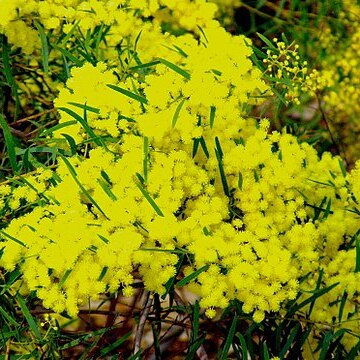Bushy shrub or tree to c. 7 m high. Branchlets slender, angled at extremities, dark reddish, glabrous. Phyllodes narrowly linear, 4-8 cm long, 1-1.6 mm wide, acute, occasionally obtuse-mucronate, thin, glabrous; midrib fine; lateral nerves absent or few and obscure; gland 7-17 mm above pulvinus, small but somewhat prominent and exserted, with pore transverse and commonly at distal end of gland. Inflorescences racemose; raceme axes 2.5-4 cm long, slender, glabrous; heads globular, small, 9-12-flowered, commonly lime yellow; peduncles 2-4 mm long, glabrous. Flowers mostly 5-merous; sepals united. Pods (immature) slightly constricted between seeds, convex on opposite sides over alternate seeds, to 7.5 cm long, 5 mm wide, moderately pruinose, glabrous. Seeds longitudinal.
Unarmed shrub or small tree. Leaves phyllodic, apparently simple, linear to narrowly oblong-elliptic, 2-4.5 cm long, 2-5 mm wide, narrowed basally, with a single main longitudinal nerve, margins typically densely ciliate, usually with a rounded gland near the base. Flowers in small round heads, arranged in axillary racemes. Pods linear-oblong, straight, flattened, up to 7 cm long and 7 mm wide, dehiscent.
Small tree or shrub, 1.5-10.0 m high. Leaves phyllodia, apparently simple, green, glabrous, linear to narrowly oblong-elliptic, straight, 20-45 x 2-5 mm, narrowed at base, single prominent midvein, margins densely ciliate. Flowers globular heads in axillary racemes, bright yellow. Flowering time July, Aug. Pod brown, linear-oblong, 70 x 7 mm, straight, flattened, dehiscent.
A tall shrub or small tree. It is often crooked. It grows 6 m tall. The bark is grey-brown and smooth. The branches can be flattened. The leaves (phyllodes) are alternate and dark green. They are 2-6 cm long by 2-5 mm wide. The tip has a sharp point. The flowers are bright yellow in round heads. The fruit is a flat pod.


